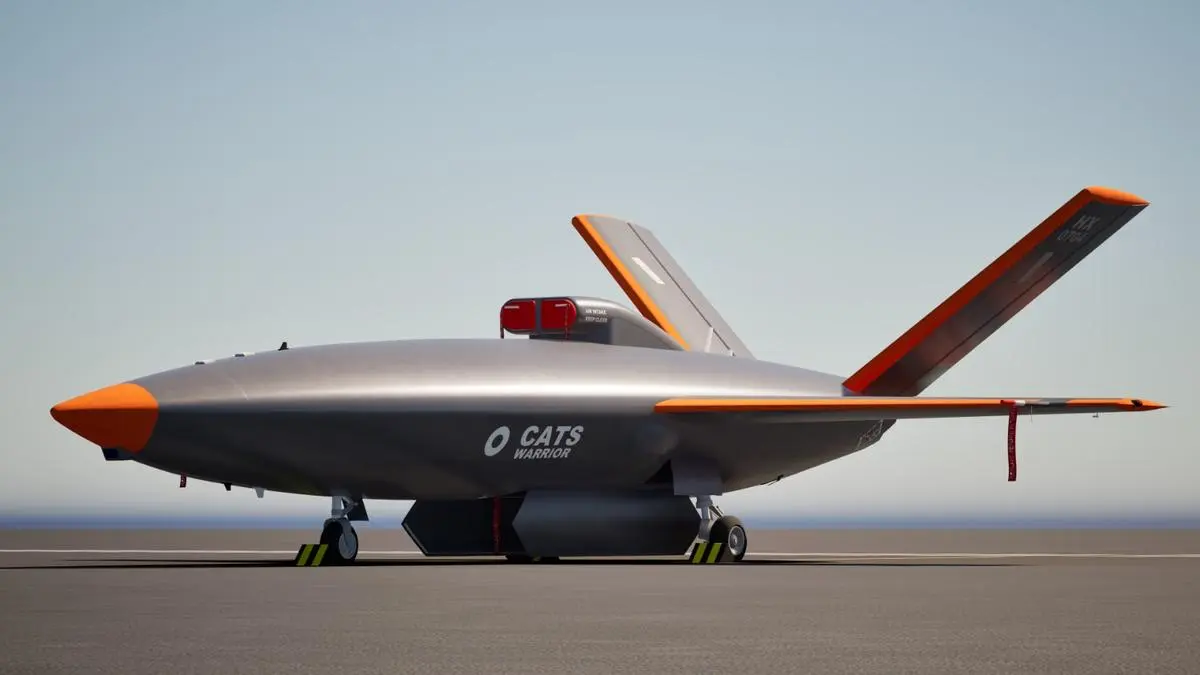Table of Contents
HAL CATS Warrior Drone: India is rapidly becoming a center of defense technology, and at the center of this shift is Hindustan Aeronautics Limited (HAL). One of its most ambitious and forward-looking projects is the Combat Air Teaming System (CATS) Warrior initiative. The initiative aims to change the face of India’s air power by allowing one fighter pilot to command and control several armed drones (otherwise referred to as loyal wingman drones), dramatically boosting the nation’s air supremacy, strike capacity, and survivability in high-threat environments.
What is the CATS Warrior Project?
The CATS Warrior (Combat Air Teaming System—Warrior) is a manned-unmanned teaming (MUM-T) concept in which a mothership fighter jet (like HAL Tejas) acts as a command platform for autonomous unmanned combat aerial vehicles (UCAVs) that will fly alongside it.
These UCAVs, referred to as “Warrior drones”, will:
-
Be semi-autonomous or fully autonomous depending on mission complexity.
-
Carry precision-strike weapons and electronic warfare (EW) payloads.
-
Conduct reconnaissance, enemy air defense (SEAD) suppression, or even kamikaze-style attacks on high-value enemy assets.
-
Be developed to swarm, defend, or attack based on the mission objective.
Feature Details Full Form Combat Air Teaming System (CATS) Warrior Developer Hindustan Aeronautics Limited (HAL) Partners DRDO, NewSpace Research & Technologies, Rolls-Royce Project Type Manned-Unmanned Teaming (MUM-T) UCAV System Mothership Aircraft LCA Tejas Mk1A / Mk2 (Modified with command systems) Unmanned Aerial Vehicle AI-powered stealth UCAVs (CATS Warrior drones) Engine Collaboration HAL + Rolls-Royce (Indigenized jet engine) Key Capabilities Combat, surveillance, electronic warfare, precision strikes Payload Capacity 100–150 lbs of bombs, EW pods, smart munitions Range (Estimated) 800–1,200 km Control Mechanism Autonomous + Real-time pilot control via secure data link Testing Platform Modified HAL Kiran aircraft with ground station control Target Users Indian Air Force (IAF), Indian Navy Strategic Advantage High-risk missions without risking pilot lives Use Cases Border defense, deep-strike missions, swarm attack, maritime security Project Milestones 2020: Concept Export Potential High – High-Cost-effective UCAVs for developing nations Technology Focus Stealth, AI algorithms, swarm coordination, real-time data sharing
Core Components of HAL CATS Warrior Drone Ecosystem
The CATS Warrior system of Hindustan Aeronautics Limited (HAL) is a revolutionary move towards India’s air combat prowess. It is not merely an individual drone but a network-centric warfare system with manned and unmanned aerial vehicles, AI, and data-link technologies integrated into it. The ecosystem enables a single pilot to fly multiple UCAVs (Unmanned Combat Aerial Vehicles) simultaneously in real time. The following is an elaborately detailed table illustrating the essential elements of the CATS Warrior ecosystem and their respective functionalities.
| Component | Type | Description & Functionality |
|---|---|---|
| CATS Warrior UCAV | Stealth Unmanned Combat Aerial Vehicle (UCAV) | A high-speed, AI-enabled, autonomous drone capable of deep-strike missions. It operates in coordination with a mothership aircraft and carries precision weapons. |
| CATS Mothership | Modified LCA Tejas (Manned Aircraft) | Acts as the command center in the air, controlled by a fighter pilot who manages the operations of multiple UCAVs in real time via secure data links. |
| CATS ALFA (Air-Launched Flexible Asset) | Loitering Munitions & Swarm Drones | Lightweight, air-launched drones deployed from the Warrior UCAV to perform swarm attacks, surveillance, jamming, and decoy missions. |
| CATS Hunter | Armed Mini Drone | Can be launched by UCAVs for short-range strike missions. Provides close-in attack capabilities against mobile ground targets. |
| CATS Infinity | Data Relay System / Satellite Mesh Network | A future-oriented communication satellite system (under development) to provide long-range, uninterrupted communication and control for all units in the ecosystem. |
| Ground Control Station (GCS) | Command and Control Center | A remote station with “pilot-in-loop” capabilities. Takes control of unmanned aircraft like the modified Kiran during test and combat scenarios. |
| Modified Kiran Aircraft | UAV Conversion Testbed | Used for data link and coordination testing between manned and unmanned aircraft. The second cockpit is automated for UCAV simulation. |
| Engine System | Jet Propulsion Unit | HAL and Rolls-Royce are co-developing a high-efficiency engine suitable for small stealth drones like the Warrior. |
| AI & Data Link Software | Communication Protocols | Ensures seamless real-time communication and coordination between the mothership, UCAVs, and supporting elements through encrypted, high-speed data links. |
HAL CATS Warrior Drone: Strategic Importance for India
Real-time Use Case: Russia-Ukraine & Israel-Hamas Wars
-
Drone warfare has become central to modern conflicts.
-
India’s CATS Warrior is built to counter:
-
Border incursions
-
High-altitude warfare (like Ladakh)
-
Maritime threats in the Indian Ocean Region
-
Strengthening India’s Strategic Autonomy
-
Reduces dependency on foreign UCAVs like the MQ-9 Reaper.
-
Boosts India’s status as a drone manufacturing hub under Make in India and Atmanirbhar Bharat.
HAL CATS Warrior Drone: Key Partnerships and Industry Collaboration
-
HAL: Lead developer of the CATS platform.
-
DRDO: Provides avionics, AI algorithms, and support systems.
-
NewSpace Research & Technologies: A Bengaluru-based start-up building the drone airframe and swarming tech.
-
Rolls-Royce: Likely to supply the indigenized jet engine for the UCAV.
-
Indian Air Force & Indian Navy: End users and strategic stakeholders.
Technical Specifications of CATS Warrior UCAV
The HAL CATS Warrior UCAV is designed to be India’s frontline autonomous combat drone, equipped with advanced stealth, AI capabilities, and precision strike features. Built for both land and naval operations, the drone balances power, endurance, and survivability. Below is a detailed table highlighting its key technical specifications, showcasing why it’s a game-changer in India’s unmanned aerial combat ambitions.
| Feature | Specification/Detail |
|---|---|
| Weight | Approx. 1.5 to 3 tonnes |
| Payload Capacity | 100–150 pounds of bombs or EW pods |
| Range | ~800–1,200 km (expected) |
| Speed | Subsonic to High-subsonic |
| Stealth Design | Radar-evading airframe |
| Autonomous Capability | Yes (via onboard AI + mothership control) |
| Role | Combat, Surveillance, Jamming |
| Launch Mode | Runway / Carrier-based (Naval Variant) |
| Engine | HAL/DRDO-Rolls-Royce collaboration |
CATS Warrior UCAV: Development Timeline
The development of the CATS Warrior UCAV has followed a well-structured timeline, with key milestones marking India’s rapid progress in autonomous drone technology. From its unveiling at Aero India to the upcoming full-scale demonstrations, HAL is aligning innovation with strategic requirements. The table below outlines the important phases in the CATS Warrior’s development journey.
| Year | Milestone |
|---|---|
| 2020 | Concept revealed at Aero India |
| 2023 | Design finalization & early component tests |
| 2024 | Engine tests and modified Kiran aircraft trials begin |
| 2026 (Planned) | First full-scale flight demonstration of MUM-T |
Future Potential and Global Reach
Military Utility:
-
High-risk bombing raids
-
Electronic warfare jamming
-
Surveillance in enemy territory
-
Escort for manned fighters during deep-strike missions
Export Potential:
-
Countries in Asia, Africa, and Latin America are looking for cost-effective UCAV systems.
-
HAL aims to position CATS Warrior as an affordable alternative to expensive Western drones.
Conclusion
The HAL CATS Warrior is not just a technological project, it’s a strategic doctrine shift. With its focus on manned-unmanned teaming, AI-based combat autonomy, and high survivability, the CATS program is building the foundation for India’s future-ready air force.
As the project moves from prototype to deployment, India will not only secure its skies but also become a global exporter of cutting-edge drone warfare technology, firmly asserting its place in the next-generation defense ecosystem.


 World Summit on Disaster Management (WSD...
World Summit on Disaster Management (WSD...
 Domestic Systemically Important Banks (D...
Domestic Systemically Important Banks (D...
 The Missing Link in India’s Critical M...
The Missing Link in India’s Critical M...

























